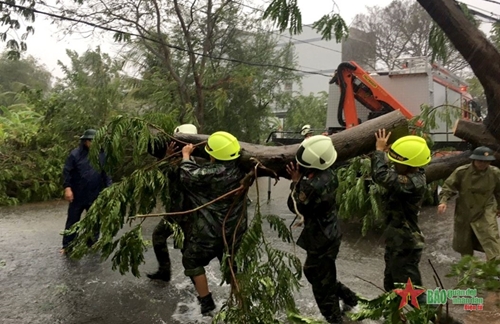The impact of a strong Southwest monsoon, accompanied by prolonged heavy rain and thunderstorms, caused a 216 sq.m of land along the right bank of the Soai Rap River in Nha Be district of Ho Chi Minh City to sink into the river. Immediately after the incident, the Military Command of Nha Be district deployed 35 officers and soldiers to the scene to reinforce the area and ensure the safety of civilian activities. They pro-actively inspected vulnerable riverbank sections to prevent further landslides. Meanwhile, in Trung My Tay ward of District 12, a heavy rainstorm and whirlwinds blew off the roofs of several houses. Thanks to thorough preparation, 30 officers and soldiers from the Military Command of District 12 promptly assisted residents in quickly recovering from the damage and restoring normal life.
    |
 |
|
Ho Chi Minh City’s armed forces clear trees which were uprooted due to strong wind and whirlwind. |
These are just two of the 11 natural disaster incidents that the city’s armed forces responded to under the "four on-the-spots" principle (on-the-spot command, on-the-spot forces, on-the-spot equipment and supplies, on-the-spot logistics) and the "three readinesses" principle (readiness for pro-active prevention, readiness for timely response, readiness for rapid and effective recovery) in disaster prevention and mitigation since early 2024. These efforts have helped protect the lives and property of the state and citizens.
This year's storm season is expected to have complicated and unpredictable developments. With high population density, numerous underground facilities, high-rise buildings, major economic establishments, and areas prone to landslides, high tides, building collapses, fires, and explosions, Ho Chi Minh City now faces significant challenges.
Deputy Chief of Staff of the Ho Chi Minh City Command Senior Colonel Pham Duc Chau Tran said that based on research, accurate forecast and assessment of the situation, the command has pro-actively developed plans and advised the municipal Party Committee and People's Committee to direct the effective application of different measures and the “four on-the-spots” and “three readinesses” principles in disaster prevention, mitigation, and search and rescue.
Implementing these principles, the command has advised and directed units and localities to strengthen civil defense, natural disaster prevention, and search and rescue agencies at all levels, especially at the district and commune levels; assigned specific tasks to each member to ensure immediate prevention and response to incidents from the outset to minimize damages. Since the early 2024, the military commands at all levels have organized numerous drills, with the focus on civil defense, strong storm response combined with high tides, search and rescue operations, and response to chemical and oil spills caused by natural disasters.
During the city's civil defense exercise, recently organized under the direction of the Party Committee and Chain-of-Command of Military Region 7, many disaster response-related activities were incorporated. Through these drills’ results, commands have updated, supplemented, and refined their plans and conducted training thoroughly. This has improved awareness, responsibility, command skills, and coordination among various agencies, sectors, and localities in responding to specific types of natural disasters and incidents.
Regarding the development of the “on-the-sport force,” the city has focused on building a district-level local force with more than 10,000 personnel and a streamlined and effective commune-level natural disaster response. These forces have been trained to enhance their overall knowledge and skills, proficiently use equipment, and execute search and rescue methods. Currently, the city has established more than 300 commune-level natural disaster prevention teams with over 21,000 members and come up with on-the-spot plans for their specific areas. In emergencies, the city coordinates to mobilize additional mobile militia forces, reserve forces, and the forces and equipment of military units stationed in the area.
Over the past ten years, the city has acquired modern, mission-appropriate equipment, such as sonar scanning devices, underwater communication equipment, and search and rescue command boats. Units have maintained regular inventory checks, maintenance, and operation to ensure that equipment is always in optimal technical condition.
The city has directed the municipal Department of Industry and Trade, the Union of Commercial Cooperatives, and local authorities to prepare food, drinking water, and supplies at evacuation and relocation sites in disaster-affected areas to meet residents' needs during emergencies. Hospitals, health centers, and commune-level infirmaries have developed plans to mobilize medical personnel to participate in rescue efforts and provide health care for the people during natural disasters. The city has also increased participation in ASEAN-level disaster response exercises, shared information and exchanged experience in forecasting, risk assessment, and specialized training in disaster response.
Col. Tran noted that from practical tasks, the Ho Chi Minh City Command has coordinated with agencies to review, supplement, and strictly enforce legal documents, establish regulations, mechanisms, policies, and standards for the use of specialized natural disaster prevention vehicles and equipment, and accelerate dissemination to raise residents’ awareness.
Translated by Tran Hoai